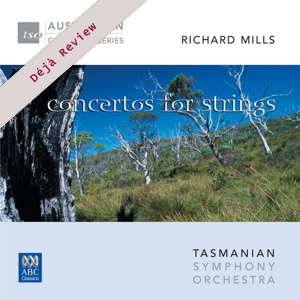
Déjà Review: this review was first published in October 2002 and the recording is still available.
Richard Mills (b. 1949)
Cello Concerto (1990)
Violin Concerto (1992)
Concerto for Violin and Viola (1994)
Sue-Ellen Paulsen (cello); Barbara Jane Gilby (violin); Janet Rutherford (viola)
Tasmanian Symphony Orchestra/Richard Mills
rec. 1996, Ballroom, Government House, Hobart, Australia
ABC Classics 4620162 [72]
Richard Mills’ three string concertos were written in fairly quick succession, between 1990 and 1994; but each of them has its own character. All three are superbly written for the soloists and Mills’ orchestral expertise sees to it that, whatever the setting, the soloist’s music always comes through clearly and directly.
The Cello Concerto is “a dramatic monologue for cello and orchestra”, as Yvonne Frindle rightly remarks. It is a tightly argued symphonic work in which all the musical material derives from the opening gestures. Its four sections are thematically connected and the basic material is organically developed, thus emphasising the symphonic structure of the whole piece. It opens with a declamatory prelude played by the cello with some orchestral outbursts punctuating the cello’s meditation. This is followed by an Allegro section leading into a meditative Adagio in turn fading into the final section Cadenza/Recitative restating variants of the earlier thematic material. The concerto ends as abruptly as it had begun. Mills’ Cello Concerto is an intense, utterly serious and often dramatic work of substance and of great beauty.
Mills’ Violin Concerto was written for Carl Pini. It is again a single movement in three linked section following the traditional fast-slow-fast pattern; and, once again, most of the music derives from the opening material consisting in a toccata-like motoric gesture followed by a lyrical cantabile. The solo part is quite demanding and difficult, but this is never virtuosity for virtuosity’s sake. Again, the single movement structure of the piece rather tends to emphasise the symphonic character of the work in which the soloist is just a partner rather than an opponent. If you respond to, say, Walton’s Violin Concerto or to Prokofiev’s concertos, you will know what to expect from Mills’ own essay in the genre.
Mills’ Concerto for Violin, Viola and Orchestra is scored for orchestral forces of almost classical proportions (single wind quintet and a small body of strings), though with piano and some percussion. This is Mills’ most classically poised concerto and the scoring for small forces results in transparent, luminous textures never obscuring the soloists’ lines. The concerto is laid-out in three movements with a fairly weighty and substantial central Passacaglia. Once again, the opening thematic material stated in the first bars provides for most of the ensuing music.
Mills’ string concertos are serious, utterly honest and often beautiful works that clearly show another facet of this composer’s music. They also demonstrate his remarkable instrumental and orchestral flair, as well as his ability to think in term of symphonic development. His concertos are no mere showpieces for instrumental virtuosity, and the soloists must be full partners rather than brilliant, but indifferent outsiders. All three are really very fine (and the Cello Concerto much more than that) and definitely deserve to be better known. I hope that these superb performances will prompt some soloists to investigate these fine, though still too little known works. I for one now look forward to hearing more of Richard Mills’ music.
Hubert Culot
Help us financially by purchasing from



















